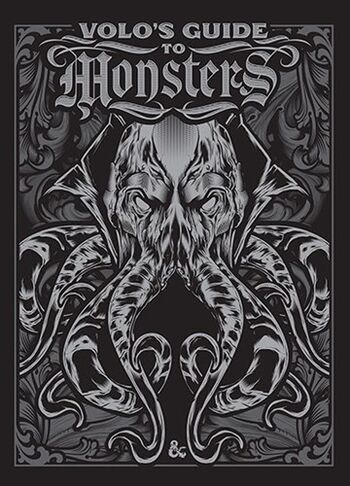 The third and final part of my monster review thing of Volo's Guide to Monsters! Not a whole ton to say, I think I've praised how much I love the Guide to Monsters enough.
The third and final part of my monster review thing of Volo's Guide to Monsters! Not a whole ton to say, I think I've praised how much I love the Guide to Monsters enough. Recently changed to add a bunch of 5E monsters that debuted here that we briefly covered in the 1E Monster Manual. It's a bit of a change that makes it a bit easier for me to shunt the 1E Manual into a 'special edition' instead of it taking up a chunk of monsters that I would've otherwise talked about here.
- Click here for the first part of Volo's, covering Girallons to Neothelids.
- Click here for the first part of Mordenkainen's Tome of Foes, covering Allips to Eidolons.
- Click here for the index.
_____________________________________________
- 5.5E/5E: Small Humanoid; Chaotic Evil; CR 1
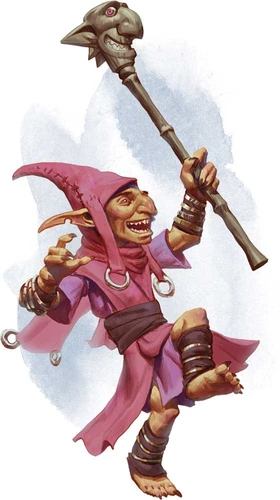 One of the huge lore lynchpins about the goblinoids in Volo's was the fact that Maglubiyet, the chief god of goblinkind, destroyed all but four of the previous pantheon of goblin gods. Which, to the writing team's credit, was pretty dang fascinating, but it also sort of ended up with a good chunk of the goblins' flavour being less about them but more about how the races are affected by the fighting of a bunch of godly entities. Apparently, though, one of the gods for the goblins is a trickster deity who ended up laying out sort of a plan to undermine Maglubiyet, where they will manifest as a spirit that possesses goblins when Maglubiyet calls for a 'Host' of the three main goblinoid races. Apparently, the resulting creature is now called a Nilbog (goblin backwards), and they will cause untold chaos in the ranks of the bugbears and hobgoblins, as a reprisal for the goblins being treated as the lowest in Maglubiyet's totem pole. The prose even notes that the Nilbog can cause other creatures to do the opposite of what they intended to do -- although in the actual combat rules, it's 'merely' a charisma check that causes those who fail it to praise the Nilbog instead. Also, apparently, since the Nilbog is like, part of the spirit of a dead god, it will just move to another goblin if you kill the Nilbog. Apparently, to dissuade Nilbogs from appearing, a Goblinoid Host will assign a goblin as a jester, allowing them to do whatever they want, or something? I'm not sure how that stops Nilbogs from spawning, but okay. It's honestly probably a bit hard to utilize this creature in your campaign unless the Goblinoid host is somehow friendly to your heroes? An interesting bit of flavour (I do like the implication that the Nilbog can not be defeated, and you can only appease or trick the spirit), but I must confess I kinda wished that there was something more about the Nilbog story. Is it just there to disrupt? What is its end-game? Is it just a dick, or is it outright hostile to Hobgoblins and Bugbears? Is it friendly to non-goblinoid groups? How do the goblins feel about the Nilbog? Will they rally aroud the Nilbog to rise up against their Hobgoblin oppressors? I feel like there's a good story in here, but it's not told particularly well.
One of the huge lore lynchpins about the goblinoids in Volo's was the fact that Maglubiyet, the chief god of goblinkind, destroyed all but four of the previous pantheon of goblin gods. Which, to the writing team's credit, was pretty dang fascinating, but it also sort of ended up with a good chunk of the goblins' flavour being less about them but more about how the races are affected by the fighting of a bunch of godly entities. Apparently, though, one of the gods for the goblins is a trickster deity who ended up laying out sort of a plan to undermine Maglubiyet, where they will manifest as a spirit that possesses goblins when Maglubiyet calls for a 'Host' of the three main goblinoid races. Apparently, the resulting creature is now called a Nilbog (goblin backwards), and they will cause untold chaos in the ranks of the bugbears and hobgoblins, as a reprisal for the goblins being treated as the lowest in Maglubiyet's totem pole. The prose even notes that the Nilbog can cause other creatures to do the opposite of what they intended to do -- although in the actual combat rules, it's 'merely' a charisma check that causes those who fail it to praise the Nilbog instead. Also, apparently, since the Nilbog is like, part of the spirit of a dead god, it will just move to another goblin if you kill the Nilbog. Apparently, to dissuade Nilbogs from appearing, a Goblinoid Host will assign a goblin as a jester, allowing them to do whatever they want, or something? I'm not sure how that stops Nilbogs from spawning, but okay. It's honestly probably a bit hard to utilize this creature in your campaign unless the Goblinoid host is somehow friendly to your heroes? An interesting bit of flavour (I do like the implication that the Nilbog can not be defeated, and you can only appease or trick the spirit), but I must confess I kinda wished that there was something more about the Nilbog story. Is it just there to disrupt? What is its end-game? Is it just a dick, or is it outright hostile to Hobgoblins and Bugbears? Is it friendly to non-goblinoid groups? How do the goblins feel about the Nilbog? Will they rally aroud the Nilbog to rise up against their Hobgoblin oppressors? I feel like there's a good story in here, but it's not told particularly well.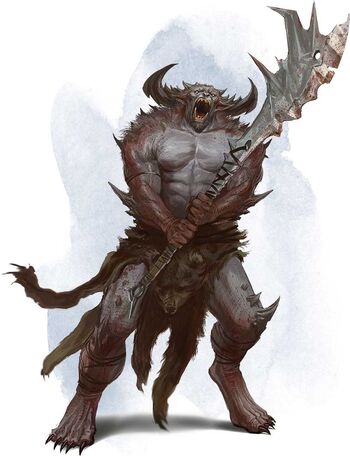
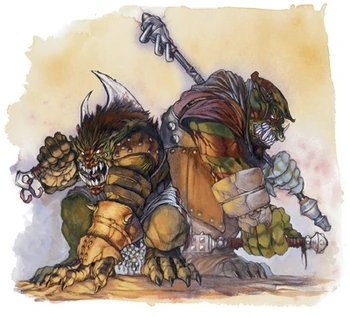
Tanarukk
- 5.5E/5E: Medium Fiend - Demon; Chaotic Evil; CR 5
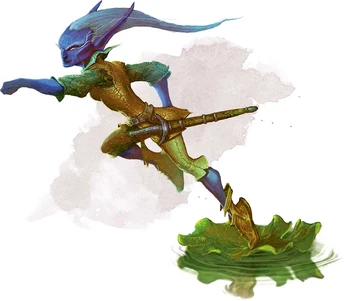
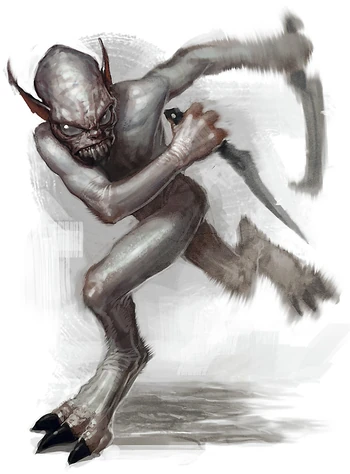
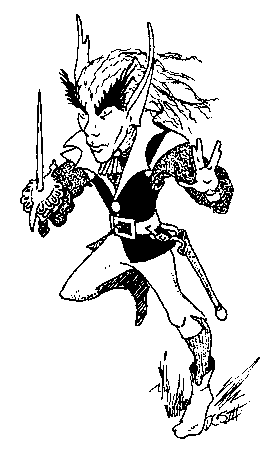
Quickling
- 5.5E/5E: Tiny Fey; Chaotic Evil; CR 1
I kinda want to note the 4E Quickling, another vast redesign. Credit where credit's due, which is actually a pretty cool-looking gremlin-ghoul creature in its own right, and has such a malicious expression... it just doesn't quite feel right for an evil fey monster, Quickling or no Quickling.
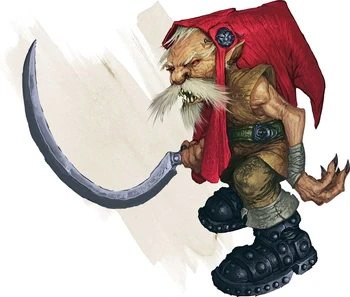
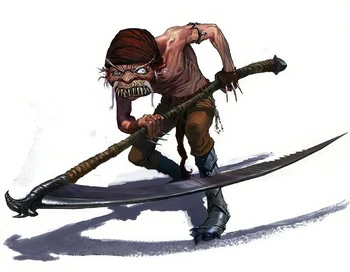
Redcap
- 5.5E/5E: Small Fey; Chaotic Evil; CR 3

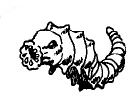
Rot Grub
- 5.5E/5E: Medium Swarm of Tiny Beasts; Unaligned; CR 1/2
Another creature that has only appeared in 1E and basically ignored all the way until 5th Edition's Volo's Guide to Monsters (that Volo, he likes all the weird shit in the original Monster Manual) is the Rot Grub. In 1E, they were shit-dwelling grubs that will burrow into the flesh of any living creature that touches them, as seen with that unfortunate, horrified fighter from 1E's artwork. They can only be killed with fire or a cure disease spell, or the rot grubs will burrow into the heart and kill the victim in "1-3 turns". Okay! 5th Edition's Volo's sneaks the Swarm of Rot Grubs into its appendix, as well as the singular Rot Grub as what's essentially a status effect. While we don't get any new artwork, we get a neat little description of how they can survive on plants, in addition to flesh both living and dead. The Rot Grub doesn't simply cause instant-death in this version, although it still burrows all the way to the heart -- instead, it deals periodic damage and there's a window of time for the victims to burn off the grubs. It's definitely a pretty creepy creature if you think about it, and, yeah, in a world populated with bizarre creatures like Grells, Ixitxachitls and Morkoths, of course even a simple maggoty creature is going to be dangerous. It's definitely a neat surprise, though, for this little bugger to show up in 5E, considering they've been absent from D&D for decades.
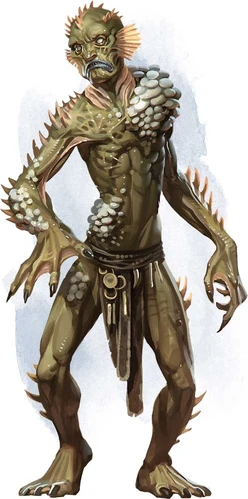
Sea Spawn
In addition to the Deep Scion, Volo's Guide to Monsters gives us another aquatic horror in the Sea Spawn, although unlike most other sea monsters, the Sea Spawn is less Cthulhu and more Pirates of the Caribbean. The Sea Spawn is based on specific tropes of maritime spooky undead, where it's not just enough that the dead come back as zombies/skeletons/ghosts or what-have-you, but as shambling men who has joined with corals, seaweed and barnacles. They can also have fishy features, too, and it's emphasized that the Sea Spawn look vastly different from individual to individual, but there's just something about being fused with immobile oceanic creatures, y'know? There's just something extra-creepy about a barnacle-coral-man as opposed to just another fish-person. D&D's Sea Spawn are sailors lost at sea, transformed by the ocean and turned into a thing that lives there, with, of course, barnacles and whatnot all around its skin. Volo suggests a bunch of possible causes of the curse that turns sailors into Sea Spawn, and apparently many creatures can do so! Volo's notes that Krakens, Morkoths, Sea Hags, Marids, Storm Giants and Dragon Turtles can all transform mortals into Sea Spawn thanks to dark bargains, tying them to the sea forevermore. Volo also suggests that at least some of the people who got turned into Sea Spawn ended up doing so after falling in love with a sea god (or merfolk, or sea elf) and spurning his/her love, which is pretty Davy Jones. Regardless, a pretty damn minion that fits as atmospheric cannon fodder for marine adversaries (and the sourcebooks also adds notes on how to make 'elite' Sea Spawn with extra abilities), and one that will allow more creative-thirsty GM's to go hog-wild in their descriptions of the different Sea Spawn around.
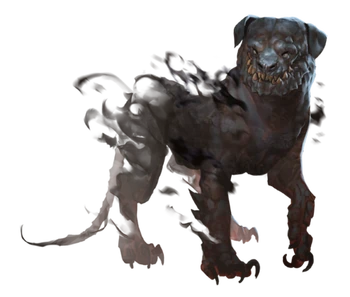
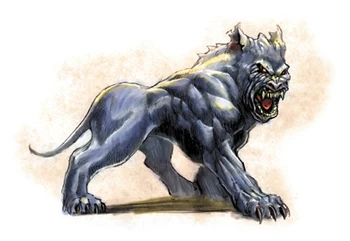
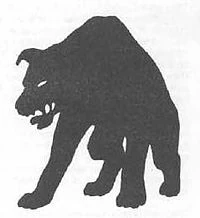
Shadow Mastiff
It's an angry hound, but it's a dog! D&D sure loves their evil dogs, between Worgs, Blink Dogs, Death Dogs, Hellhound, and probably a half-dozen more I forgot about. These evil doggos are made out of living shadow, and hail from the plane of Shadowfell, crossing over into the real world as a massive pack, and they sort of have a bunch of properties we already associate with shadow creatures. Stronger in the shadows, burned by sunlight, ability to sense creatures in other planes... I love dogs, and the set of abilities are neat, but I feel like they just don't offer a whole ton of anything for me to talk about. It's cool, and I'm definitely a fan of its 5E artwork.

Sea Spawn
- 5.5E/5E: Medium Humanoid; Neutral Evil; CR 1



Shadow Mastiff
- 5.5E/5E: Medium Monstrosity; Neutral Evil; CR 2 (regular), 3 (Alpha)
- 5.5E/5E: Medium Ooze; Chaotic Evil; CR 3
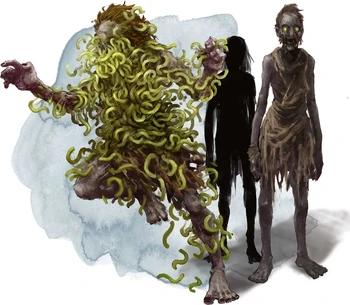
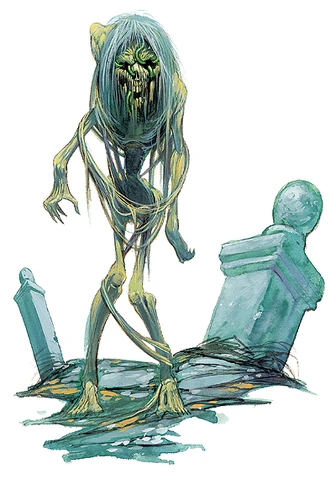
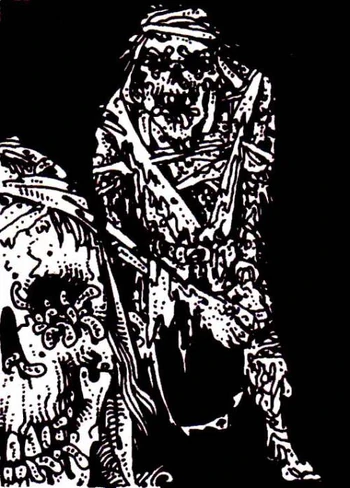
Spawn of Kyuss
- 5.5E/5E: Medium Undead; Chaotic Evil; CR 5
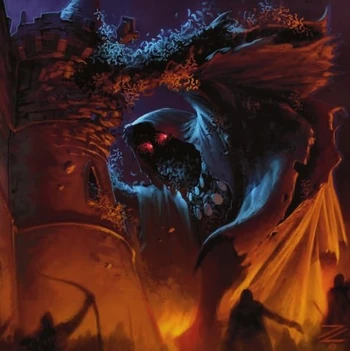 Oh, hey, one of my favourite monsters, the Spawn of Kyuss! Or, well, "Son of Kyuss" in some editions. Kyuss is a crazy demon-god creature who has differing origins depending on the setting, going from a mighty high priest of Orcus in 5E to being a powerful demigod who's ascended to godhood in 3.5E. Kyuss himself is known as the "Worm that Walks", because... well, his body is comprised entirely of worms. We could go on and on about Kyuss himself, but, of course, the elder evils of the world only show up for the final battle. For the most part, though, you have to contend with Kyuss's minions, the Spawns of Kyuss, created by the crazy cults that worship Kyuss and await his return and rise. In all the editions that it has shown up in, the Spawn of Kyuss resembles a random, normal zombie... until you come close enough and the worms within start coming out. 3E's artwork doesn't show it quite well, but both 1E and 5E show both the default 'just a zombie' state, and a neat zoom-in in 1E and a completely monstrous "holy fuck what's going on worms everywhere" form in 5E. As you fight the zombie body of the Spawn of Kyuss, the worms will jump out of it and burrow into the enemy's flesh, essentially a far, far creepier version of the Rot Grubs. It's like a far more efficient version of the xenomorph life cycle! The worms will make their way into the host's head, kill it, and then turn its corpse into another Spawn of Kyuss. Worse than just a bunch of parasitic worms, too, is the fact that the Spawn of Kyuss will trap the soul of its victims, preventing the individual from being raised from the dead until the body is destroyed. And if you do? It's likely that the trapped soul are driven insane by the constant visions of worms and the incoming elder god. I do love the Spawn of Kyuss. While individually they're just sort of a creepier combination of zombies and parasites, the fact that this ties in nicely into a huge plot hook (even if to my knowledge Kyuss hasn't shown up in any actual 5E adventure yet)
Oh, hey, one of my favourite monsters, the Spawn of Kyuss! Or, well, "Son of Kyuss" in some editions. Kyuss is a crazy demon-god creature who has differing origins depending on the setting, going from a mighty high priest of Orcus in 5E to being a powerful demigod who's ascended to godhood in 3.5E. Kyuss himself is known as the "Worm that Walks", because... well, his body is comprised entirely of worms. We could go on and on about Kyuss himself, but, of course, the elder evils of the world only show up for the final battle. For the most part, though, you have to contend with Kyuss's minions, the Spawns of Kyuss, created by the crazy cults that worship Kyuss and await his return and rise. In all the editions that it has shown up in, the Spawn of Kyuss resembles a random, normal zombie... until you come close enough and the worms within start coming out. 3E's artwork doesn't show it quite well, but both 1E and 5E show both the default 'just a zombie' state, and a neat zoom-in in 1E and a completely monstrous "holy fuck what's going on worms everywhere" form in 5E. As you fight the zombie body of the Spawn of Kyuss, the worms will jump out of it and burrow into the enemy's flesh, essentially a far, far creepier version of the Rot Grubs. It's like a far more efficient version of the xenomorph life cycle! The worms will make their way into the host's head, kill it, and then turn its corpse into another Spawn of Kyuss. Worse than just a bunch of parasitic worms, too, is the fact that the Spawn of Kyuss will trap the soul of its victims, preventing the individual from being raised from the dead until the body is destroyed. And if you do? It's likely that the trapped soul are driven insane by the constant visions of worms and the incoming elder god. I do love the Spawn of Kyuss. While individually they're just sort of a creepier combination of zombies and parasites, the fact that this ties in nicely into a huge plot hook (even if to my knowledge Kyuss hasn't shown up in any actual 5E adventure yet)
Lurker & Trapper
- 5.5E/5E: Large Monstrosity; Unaligned; CR 3
The Trapper ended up, like many other 1E monsters, showing up in Volo's Guide to Monsters in 5E after a couple of brief 'easter egg' appearances in like, Dragon magazine or in bestiary appendixes, and it seems that the Trapper and the Lurker have been essentially rolled into a singular 'sheet monster that hides as part of a room', and is described to be a manta-like creature that can change the colour and texture of its body. We get a couple of descriptions about how it likes to use the bones of its former prey as bait, and how it can't camouflage as organic objects like grass. Still, honestly, not the most interesting thing out there, and sort of cheesy, but as someone who champions the goofier creatures of the game, there's definitely people out there who like the wackiness of the Lurker and Trapper enough. And hey, at least the update was faithful to the original concept, right?


Tlincalli (a.k.a. Scorpionfolk)
- 5.5E/5E: Large Monstrosity; Neutral Evil; CR 5
The Tlincalli are nomads that wander through the desert, hunting at dawn and dusk and burying themselves under the sand in other times. They're tribal and move around, only settling down to reproduce and lay eggs (which are coated in poison to trap any egg thieves). The Tlincalli aer hunters that eat what theyh kill, but sometimes take enemies prisoner with those spiky chains to bring them back to their hive and share it with their young. Mechanically they aren't super-duper exciting either, just essentially combining the poisonous stings of a scorpion and the ability to reason and fight.It's also noted that the Tlincalli have a "bow down to the strongest" mentality going on, and tribes will sometimes bow down and become obedient to more powerful hunters like blue dragons. Overall, a pretty damn cool-looking scorpion-man! I'm a huge fan.
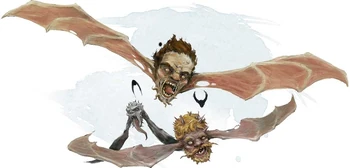
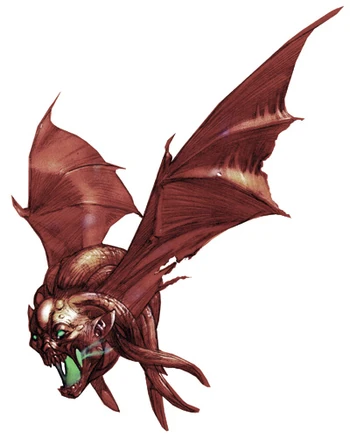
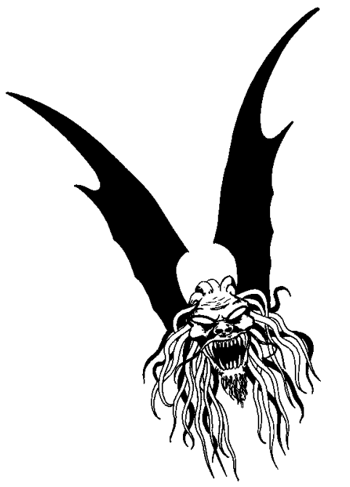
Vargouille
- 5.5E/5E: Tiny Fey; Chaotic Evil; CR 1
Like, what the hell. I love the fact that these things exist. That among the bestiaries of D&D, these demon-ticks that take the form of flying heads whose wings have transformed into bat-wings will fly around, hitch rides on larger demons, kiss humans and then spread what's essentially a zombie plague that turns your heads into flying bat-ear-winged fiends. Absolutely love the 5E art the best out of these three -- the 3E one looks a bit too try-hard in being serious, whereas the 5th Edition artwork, particularly the blonde Vargouille with the mustache, really do sell the simultaneous ridiculousness and horror of the Vargouille's reproduction and creation.
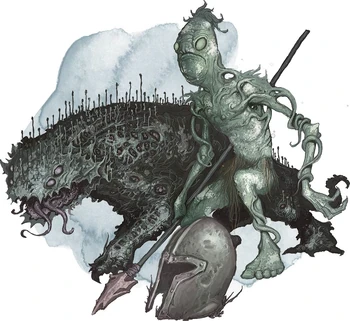
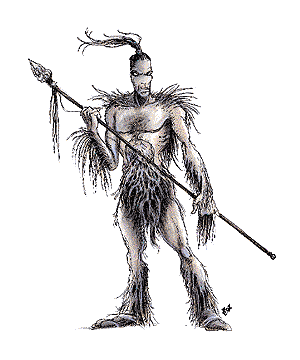
Vegepygmy (& Thorny!)
- 5.5E/5E: Small Plant; Neutral; CR 1/4 (Vegepygmy), 2 (Chief)
- 5.5E/5E: Medium Plant; Neutral; CR 1 (Thorny)
When it's a beast that gets killed by the Russet Mold, it's a Thorny that is formed, and hoo boy I absolutely love the monstrous, frog-faced dinosaur creature seen in the 5E artwork, with the rows and rows of mycellium and filaments reaching upwards that apparently are supposed to be thorns. Very cool and creepy! While the 'alien' part of their backstory clearly doesn't come into play too much, I'm a huge fan of these creepy, mold-men born out of infecting random humans!
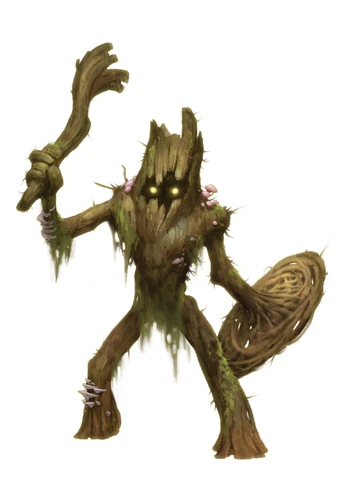
Wood Woad
- 5.5E/5E: Medium Plant; Lawful Neutral; CR 5
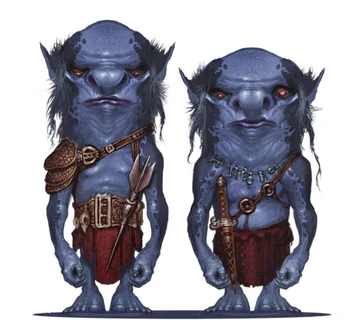
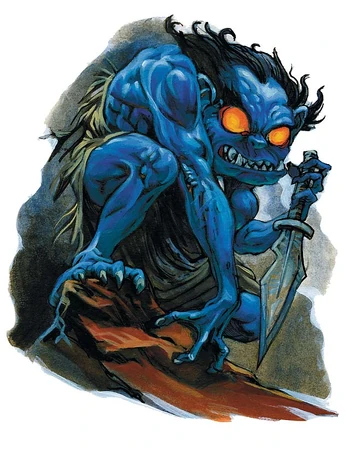
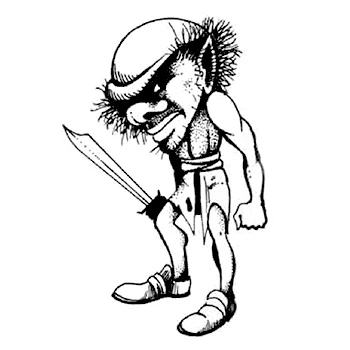
Xvart
- 5.5E/5E: Small Humanoid; Chaotic Evil; CR 1/8 (Xvart), 1 (Warlock of Raxivort)
They have blue skin, orange eyes, and, apparently it's important that they all have receding hairlines. Okay. They're cowardly and live a mostly scavenging life, and have an affinity in controlling rats and bats. They're all greedy, they're unable to reproduce, and they're just obsessed with the acquisition of valuables, and sometimes kidnap random humans or whatever to sacrifice to their god. The backstory is interesting, but the Xvarts themselves are just greedy blue midgets with a foul attitude.
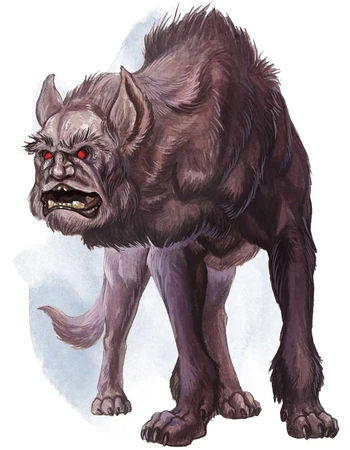
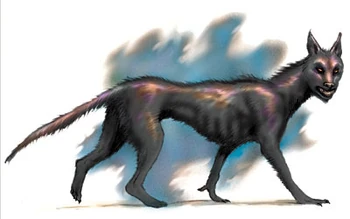
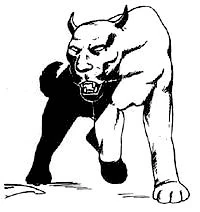
Yeth Hound
- 5.5E/5E: Large Fey; Neutral Evil; CR 4
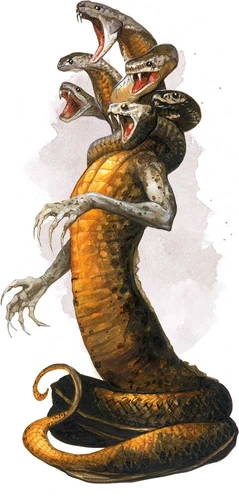
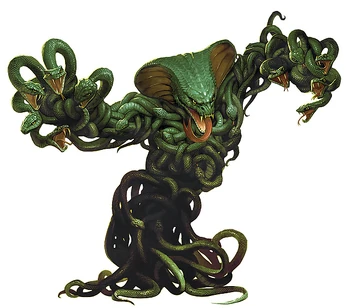
Yuan-ti Anathema
- 5.5E/5E: Huge Monstrosity; Neutral Evil; CR 12
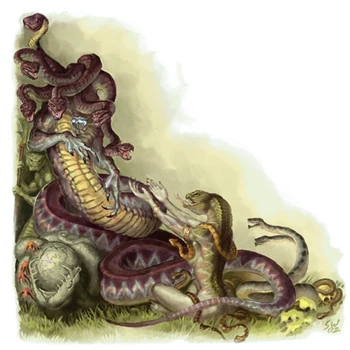 I had debated on putting the Yuan-ti variants below the break or above it, but I guess since I placed the Hag and Illithid race variants as their own thing... yeah, have some snakes! And it's not like I'm complaining that I get to write more about Yuan-ti. The Yuan-ti Anathema is apparently even higher than the abomination in terms of ranks, a mutated Yuan-ti Abomination that has undergone a foul ritual to attempt to become a god. 5E's Anathema artwork is pretty cool, showing an Abomination-style body with a bunch of extra snake-heads, but it pales in comparison to the utter insanity of the 4th Edition artwork, a mass of snakes that coil into an even larger snake-man person. Sure, 4E's Anathema doesn't look particularly stable, and 'swarm of smaller creatures making a humanoid body' is kind of a common trope among D&D enemies, but it's still pretty dang cool!
I had debated on putting the Yuan-ti variants below the break or above it, but I guess since I placed the Hag and Illithid race variants as their own thing... yeah, have some snakes! And it's not like I'm complaining that I get to write more about Yuan-ti. The Yuan-ti Anathema is apparently even higher than the abomination in terms of ranks, a mutated Yuan-ti Abomination that has undergone a foul ritual to attempt to become a god. 5E's Anathema artwork is pretty cool, showing an Abomination-style body with a bunch of extra snake-heads, but it pales in comparison to the utter insanity of the 4th Edition artwork, a mass of snakes that coil into an even larger snake-man person. Sure, 4E's Anathema doesn't look particularly stable, and 'swarm of smaller creatures making a humanoid body' is kind of a common trope among D&D enemies, but it's still pretty dang cool!Anathemas are noted to be utterly cruel and assholish, even to their own Yuan-ti kind, thanks to them viewing themselves as essentially demigods. And... well, the rest of the Yuan-ti people don't really want that, I guess. Anathemas will eventually build a massive cult of personality either way, though, with a bunch of lesser Yuan-ti gathering around it as the 'pinnacle of the serpentine form'. Oh, and Anathemas also end up being immortal, so I guess there's some truth to the insane godhood-spewing ego that the Anathemas have? Regardless, a pretty dang cool looking 'final boss' for the Yuan-ti.
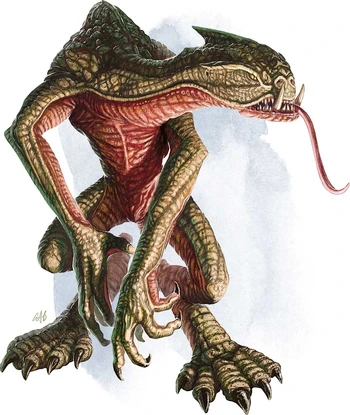
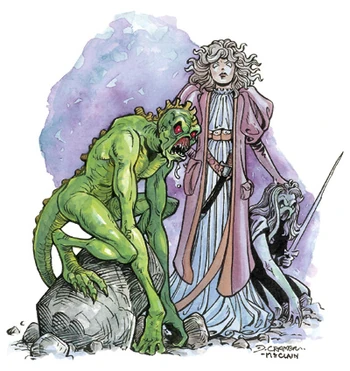
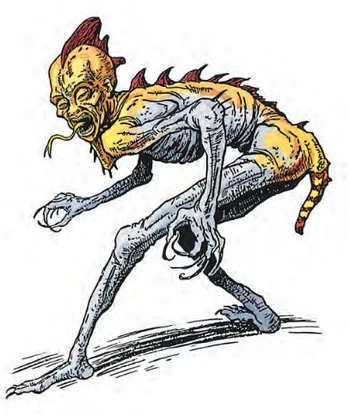
Yuan-ti Broodguard (a.k.a. Histachii)
- 5.5E/5E: Medium Monstrosity; Neutral Evil; CR 2
Where the Yuan-ti Anathema are the pinnacle of snakiness, the Broodguards are the exact opposite, and are actually more of a slave race and a bunch of brutes compared to the existing Yuan-ti. They are apparently regular humanoids that are transformed by the Yuan-ti into a hulking, reptile-man brute with little to no intelligence. As their name implies, they mostly just guard the colony and the egg piles. Thanks to their conditioning, they're super-duper obedient to all Yuan-ti. It's a pretty neat little addition to Yuan-ti lore, and adds a layer of creepy depravity to everything that we already know about the Yuan-ti. Design-wise, I feel like it's... kinda basic? It's just a lizard-man with a couple of extra snakey features, but it does make for a neat set of goons for the Yuan-ti, I suppose.
The appendix for Volo's also includes the stats for Rot Grubs (who we covered in our 1E coverage). The artwork for the Rothe also features a Tressym, but we'll talk about flying kitties in more detail when we reach the next bestiary book.
A couple more 'race variations'! I debated on whether I should put the Yuan-ti above, since I did place the Alhoons and Ulitharids pre-break, and ultimately decided on doing so. We only have orcs this time around, as well as the appendix segment of Volo's.
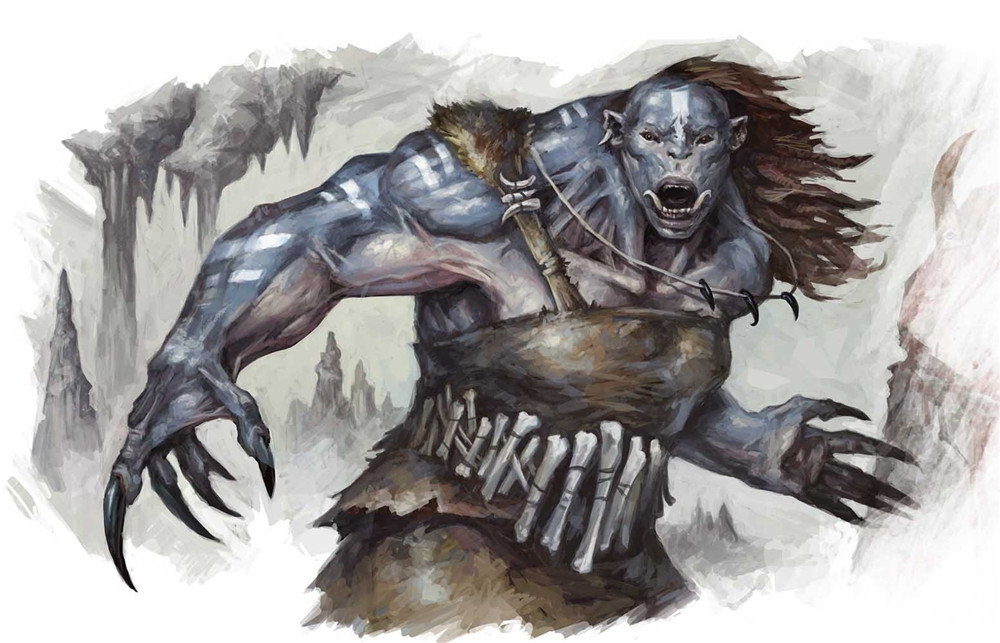

Orcs
The appendix for Volo's also includes the stats for Rot Grubs (who we covered in our 1E coverage). The artwork for the Rothe also features a Tressym, but we'll talk about flying kitties in more detail when we reach the next bestiary book.
A couple more 'race variations'! I debated on whether I should put the Yuan-ti above, since I did place the Alhoons and Ulitharids pre-break, and ultimately decided on doing so. We only have orcs this time around, as well as the appendix segment of Volo's.

Orcs
- 5.5E/5E: Medium Humanoid; Chaotic Evil; CR 4 (Blade of Ilneval), 2 (Claw of Luthic), 2 (Hand of Yurtrus), 1/2 (Nurtured One of Yurtrus), 3 (Red Fang of Shargaas)
We get a couple of 'outsiders' that live in the shadows and hidden tunnels in any given orc encampment, sort of like the pariahs that the orcs view as a disgusting but necessary part of their culture. The Hands of Yurtrus revere the orc god of death and disease, and Yurtrus's followers dwell on the fringes of the community, only communicating through Claws of Luthic. The Hands of Yurtrus wear gloves made out of the skin of other humanoids in homage to their god's smooth white hands. When an orc tribe gets sick, the Hands of Yurtrus isolate the sick, then transforms those who cannot be cured into Nurtured Ones of Yurtrus (also pictured), sending them off as nasty, pus-ridden biological weapons that... uh... look pretty hideous. Very video-gamey, I approve. Last among them are the Red Fangs of Shargaas, the orc deity of darkness and sneakiness, and they are all the pariahs and weaklings of the race, raised to become outsiders of the tribe that specialize in assassination and covert operations. They ride giant bats, which is freaking awesome and the artwork for the Fang of Shargaas is pretty badass.

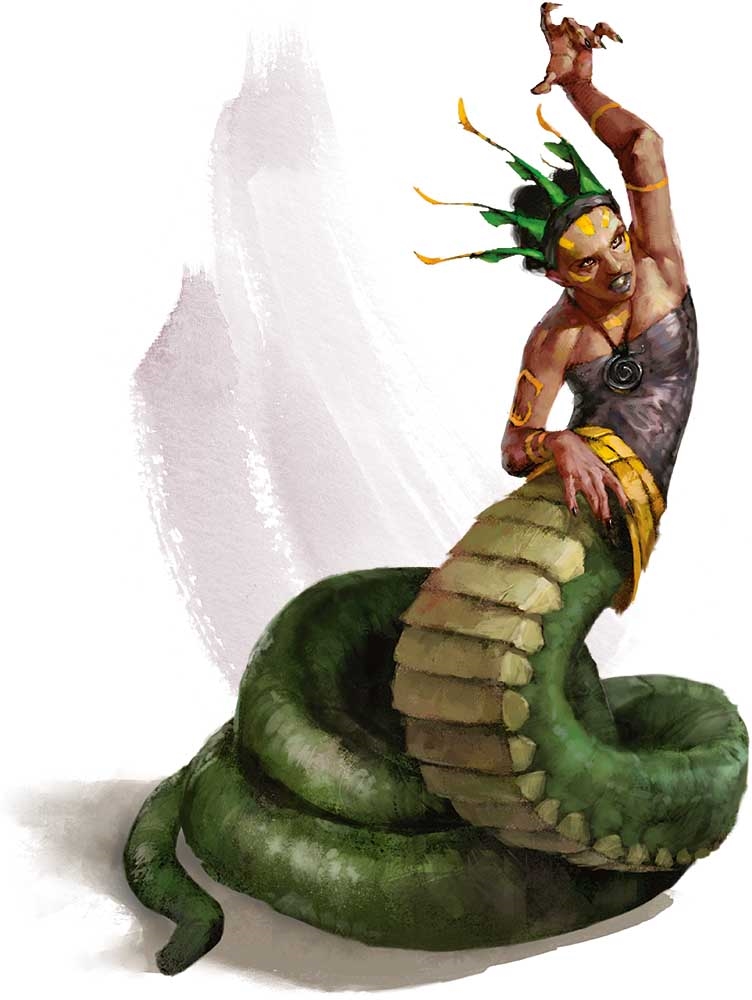

Yuan-ti Malison Variants
- 5.5E/5E: Medium Monstrosity; Neutral Evil; CR 4 (Mind Whisperer), 4 (Nightmare Speaker), 5 (Pit Master)
The Yuan-ti Nightmare Speaker serves another serpent god, Dendar, and feeds their deity the fears and nightmares of their victims, and essentially act as oracles and clerics that take their signs from the nightmares that their gods give them, and they're extra-cruel in bullying lesser beings. The Nightmare Speaker is represented with what's basically the mythological-lamia body, with the upper body of a human and the lower body of a snake. It's not an Abomination, though -- Abominations also have a snake head!
Last but certainly not least is the utterly bizarre-looking Yuan-ti Pit Master, serving the sleeping snake god Merrshaulk, and the most 'traditionalist' among the Yuan-ti. Unfortunately, 'traditionalist' means that they are extra-fervent in all this human sacrifice and blood sacrifice and whatnot, and are the most hostile against other races, wanting to subjugate them the most. Perhaps the coolest and most bizarre design among the Yuan-ti Malisons, the Pit Masters have human bodies, but arms that are just masses of snakes. Creepy!
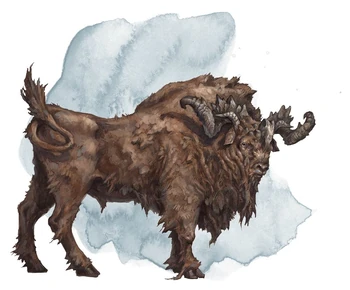
Aurochs
The Aurochs is a now-extinct species of bull, and like most prehistoric creatures, they're bigger than modern ones! I mostly know of Aurochs because the Game of Thrones novels really loved using Aurochs as descriptors instead of bulls. D&D Aurochs aren't just big bulls, though, but apparently is associated with Bahgtru, the son of the orc god Gruumsh, so the Aurochs are particularly associated with the orcs. I just assume that the creative team did this because the Aurochs sound kinda like orcs, and if that is the reasoning, two thumbs-ups for whoever decided that.
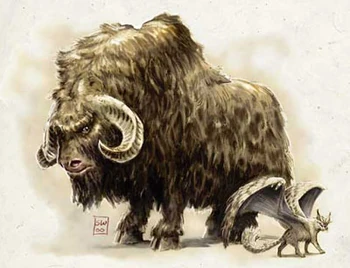
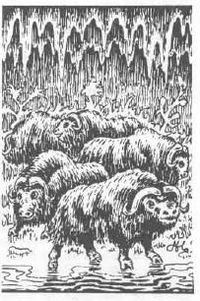

Cattle: Rothe & Stench Kow
Cows and bulls don't get a stat block in the 5th Edition Monster Manual, and alongside the dolphin, they are the only regular animals to get stat blocks in Volo's. In addition to the boring ol' ox, thogh, we get two D&D-specific cows that are a homage to some of the 'animals but with an ability. The Rothe hasn't shown up since 1E and 2E, and are apparently just like musk ox? And smaller versions called Deep Rothe live underground, and communicate with each other with flashing lights. Like firefly cows! The Stench Kow, in addition to spelling the word 'cow' in 90's teenager lingo, are... well, they're stinky hell-cows. That's literally all there is to it. It's a
Appendix: Random NPC's
________________________________________
The 5E stats for the creatures here:- Nilbog: Small humanoid - goblinoid; chaotic evil; CR 1
- Orc Blade of Ilneval: Medium humanoid - orc; chaotic evil; CR 4
- Orc Claw of Luthic: Medium humanoid - orc; chaotic evil; CR 2
- Orc Hand of Yurtrus: Medium humanoid - orc; chaotic evil; CR 2
- Orc Nurtured One of Yurtrus: Medium humanoid - orc; chaotic evil; CR 1/2
- Orc Red Fang of Shargaas: Medium humanoid - orc; chaotic evil; CR 3
- Tanarukk: Medium fiend - demon orc; chaotic evil; CR 5
- Quickling: Tiny fey; chaotic evil; CR 1
- Redcap: Small fey; chaotic evil; CR 3
- Sea Spawn: Medium humanoid; neutral evil; CR 1
- Shadow Mastiff: Medium monstrosity; neutral evil; CR 2
- Shadow Mastiff Alpha: Medium monstrosity; neutral evil; CR 2
- Slithering Tracker: Medium ooze; chaotic evil; CR 3
- Spawn of Kyuss: Medium undead; chaotic evil; CR 5
- Tlincalli: Large monstrosity; neutral evil; CR 5
- Trapper: Large monstrosity; unaligned; CR 3
- Vargouille: Tiny fiend; chaotic evil; CR 1
- Vegepygmy: Small plant; neutral; CR 1/4
- Vegepygmy Chief: Small plant; neutral; CR 2
- Thorny: Medium plant; neutral; CR 1
- Wood Woad: Medium plant; lawful neutral; CR 5
- Xvart: Small humanoid - xvart; chaotic evil; CR 1/8
- Xvart Warlock of Raxivort: Small humanoid - xvart; chaotic evil; CR 1
- Yeth Hound: Large fey; neutral evil; CR 4
- Yuan-ti Anathema: Huge monstrosity - shapechanger yuan-ti; neutral evil; CR 12
- Yuan-ti Broodguard: Medium humanoid - yuan-ti; neutral evil; CR 2
- Yuan-ti Mind Whisperer: Medium monstrosity - shapechanger yuan-ti; neutral evil; CR 4
- Yuan-ti Nightmare Speaker: Medium monstrosity - shapechanger yuan-ti; neutral evil; CR 4
- Yuan-ti Pit Master: Medium monstrosity - shapechanger yuan-ti; neutral evil; CR 5
- Aurochs: Large beast; unaligned; CR 2
- Cow: Large beast; unaligned; CR 1/4
- Dolphin: Medium beast; unaligned; CR 1/8
- Swarm of Rot Grubs: Medium swarm of tiny beasts; unaligned; CR 1/2
Humanoid NPC stats:


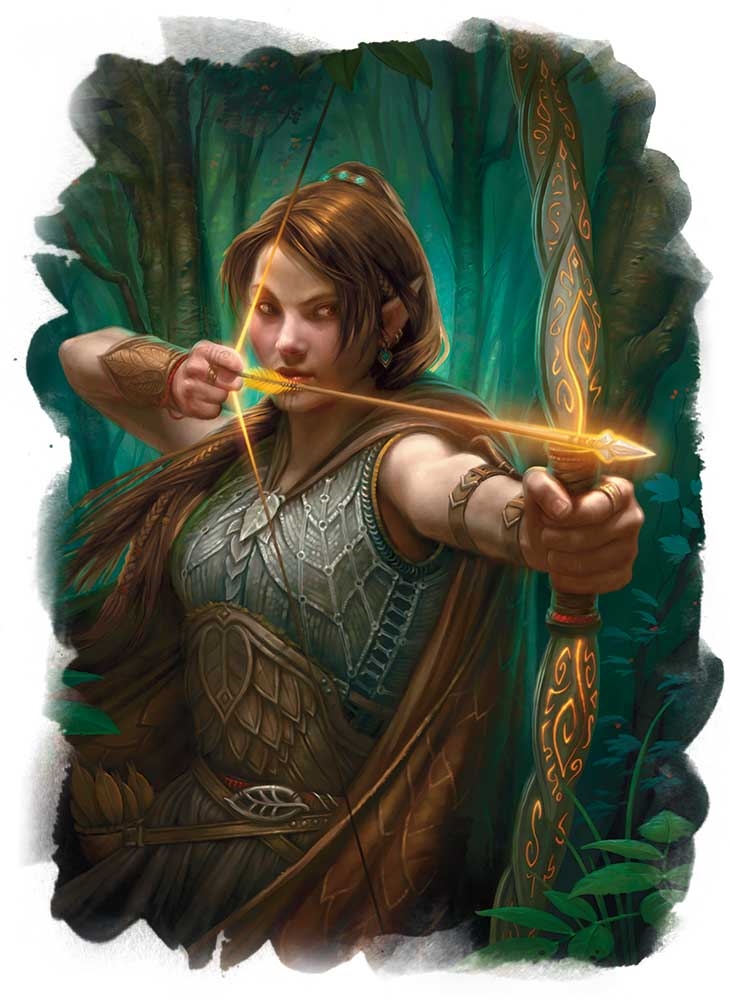

- Abjurer: Medium humanoid - any race; any alignment; CR 9
- Apprentice Wizard: Medium humanoid - any race; any alignment; CR 1/4
- Archdruid: Medium humanoid - any race; any alignment; CR 12
- Archer: Medium humanoid - any race; any alignment; CR 3
- Bard: Medium humanoid - any race; any alignment; CR 2
- Blackguard: Medium humanoid - any race; any non-good alignment; CR 8
- Champion: Medium humanoid - any race; any alignment; CR 9
- Conjurer: Medium humanoid - any race; any alignment; CR 6
- Diviner: Medium humanoid - any race; any alignment; CR 8
- Enchanter: Medium humanoid - any race; any alignment; CR 5
- Evoker: Medium humanoid - any race; any alignment; CR 9
- Illusionist: Medium humanoid - any race; any alignment; CR 3
- Kraken Priest: Medium humanoid - any race; any evil alignment; CR 5
- Martial Arts Adept: Medium humanoid - any race; any alignment; CR 3
- Master Thief: Medium humanoid - any race; any alignment; CR 5
- Necromancer: Medium humanoid - any race; any alignment; CR 9
- Swashbuckler: Medium humanoid - any race; any non-lawful alignment; CR 3
- Transmuter: Medium humanoid - any race; any alignment; CR 5
- War Priest: Medium humanoid - any race; any alignment; CR 9
- Warlock of the Archfey: Medium humanoid - any race; any alignment; CR 4
- Warlock of the Fiend: Medium humanoid - any race; any alignment; CR 7
- Warlock of the Great Old One: Medium humanoid - any race; any alignment; CR 6
- Warlord: Medium humanoid - any race; any alignment; CR 12
No comments:
Post a Comment